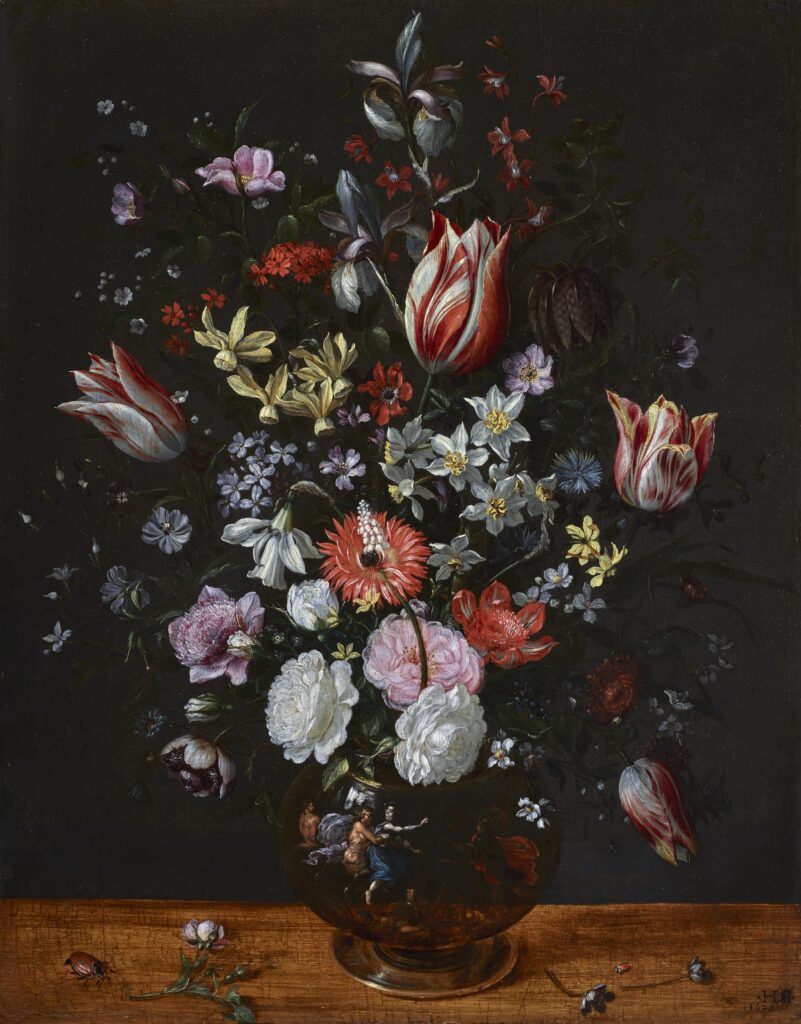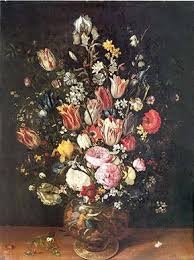Monogrammist HDB and Frans Francken II
Active 1629
A Still Life of Flowers including Roses, Tulips, Daffodils, and Irises in a Vase Decorated with Scenes from Mythology


Medium:
Oil on Panel
Category:
Dimensions:
43.2(h) x 34.3(w) cms
Framed Dimensions:
54(h) x 45(w) cms
Signed:
Signed with Initials and Dated: 'HDB / 1629'
Essay:
Little is known about this early flower painter. The artist worked in Antwerp and was evidently much influenced by the works of the numerous great flower painters working in the city at that time. The works of Andries Daniels (active 1599 - c.1640) are stylistically extremely close and it is likely that the two artists worked together.
It has been suggested by Prof. Fred Meijer that the Monogrammist HDB and Andries Daniels worked together very closely. There is a distinct similarity in their manner and compositions. Perhaps the anonymous HDB was a pupil of Daniels working in the same studio. One piece of evidence to support this theory is a flower still life by Daniels which features the same vase as seen in the present painting (see fig. 1). Meijer has suggested that the former work is a collaboration between Daniels, who painted the flowers, and Frans Francken II, who painted the vase. At Meijer's suggestion we can safely attribute the vase in the present painting to Francken as well. Only one other work by the Monogrammist HDB is known (National Gallery of Art Washington, accession no. 2003.140.1) and this third work is also a collaboration with Francken. This makes the present painting an important addition to the artist's oeuvre.
During the 17th century there was a great degree of specialisation in the flower still life genre and it was common for flowers to be painted by one artist and any figurative element (e.g. on a vase or the central area within a garland) by another, as was often the case between Daniels and Francken. The scene on the vase in the present painting could depict The Battle of the Lapiths and Centaurs. The flowers include flaming tulips, roses, hollyhock, daffodils, snakes head fritillary, forget-me-not, and several varieties of anemone, while spring snowflake and apple blossom are dotted around the periphery.
Dr Ludwig Mond was a born in Kassel, Germany in 1839. He studied chemistry and in 1873 moved to Britain where he participated in several highly successful ventures in the field. Most notable was his discovery in 1890 of an efficient method of refining nickel and later founded the Mond Nickel Company. Mond was also a social pioneer and was among the first of the great capitalists of the era to offer paid holidays and welfare benefits to his employees. He was a member of the Royal Society and during his lifetime was greatly honoured by his peers in the scientific community.
At Mond's death he donated much of his collection of Old Master paintings to London's National Gallery. Among these were The Mond Crucifixion by Raphael, as well as works by Titian, Palma Vecchio, Lucas Cranach the Elder, Carlo Crivelli, and Fra Bartolommeo.
Figure 1 see image above: Andries Daniels and Frans Francken II, Bunch of Flowers in a Decorated Metal Vase, c. 1625, oil on panel, 60.5 x 45.8 cm, present location unknown.
Provenance:
Collection of Dr Ludwig Mond (1839 – 1909);
By descent to William F. A. Mond (1928 – 1999), Wiltshire.